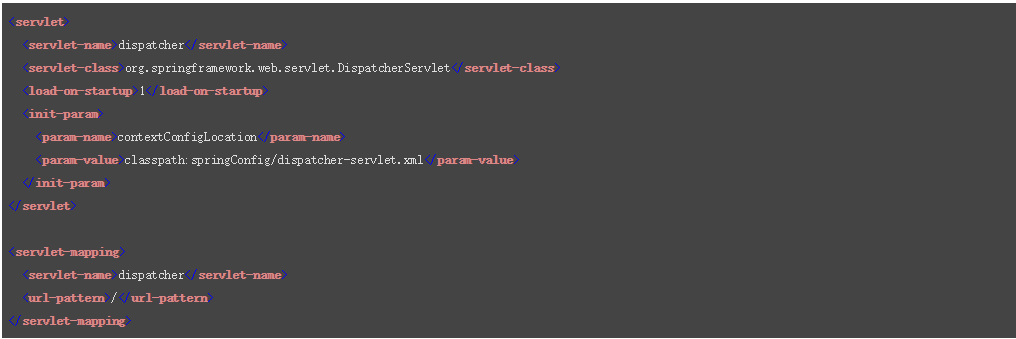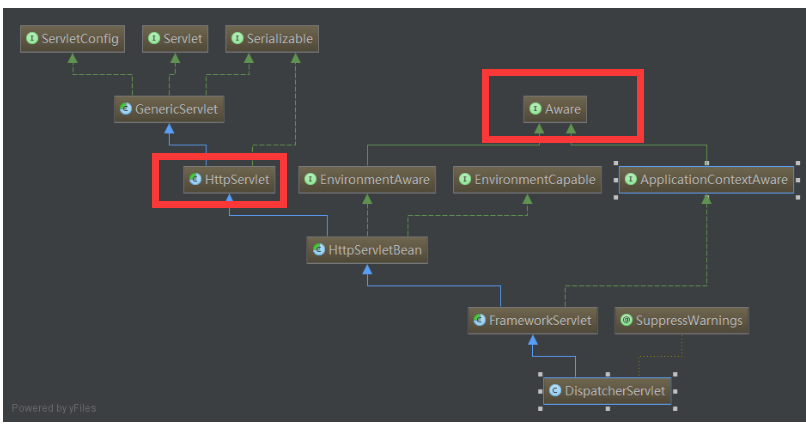概述
MVC大家比较熟悉,M即model,是业务处理层,与我们开发中的(service、dao、model)等对应起来;V即view,是视图层,以前jsp、freemarker、velocity等,现在都是前后端分离了,只返回数据了。C,即controller,控制器,可以分为前端控制器(负责请求的分发,即DispatcherServlet)、映射处理器(uri与处理方法的映射,即HandlerMapping)、业务控制器(即我们的controller层)、视图解析器(即ViewResolver)
三层架构与MVC的区别和联系
- MVC是站在BS结构的视角去看待问题,是为了把业务逻辑和用户界面分离开
- 分层是站在程序架构的视角去看待问题的 ,把业务的不同处理过程进行封装,如果需要我们可以分为更多层次,把整个事务分为数据访问层、业务处理层、视图层
- 两者的目的都是为了分层、 解耦
下面是我们常见的配置,DispatcherServlet就是springMVC的入门。再下面是DispatcherServlet的类图, Aware接口我们知道会向实例中注入一种IOC容器相关的信息。和IOC类似,可以分为两个过程,先对两个过程简单分析,核心的内容放在后面的文章进行分析
- 初始化过程
- 请求过程


初始化过程
由于上面我们配置文件虽配置了load-on-startup为,也就是说在容器启动时就会进行加载DispatcherServlet。我们看下实例化方法,发现只设置了是否可以分发OPTIONS请求,没有什么其它事情。接下来就是init方法的分析,下面从这里开始
- 初始化方法,关注两件事
- 给DispatcherServlet实例设置属性,比较上面配置的contextConfigLocation
- 初始化Servlet,IOC容器的启动等都在这里发生
//HttpServletBean类的方法
//初始化方法
public final void init() throws ServletException { if (logger.isDebugEnabled()) { logger.debug("Initializing servlet '" + getServletName() + "'"); } // Set bean properties from init parameters. PropertyValues pvs = new ServletConfigPropertyValues(getServletConfig(), this.requiredProperties); if (!pvs.isEmpty()) { try { BeanWrapper bw = PropertyAccessorFactory.forBeanPropertyAccess(this); ResourceLoader resourceLoader = new ServletContextResourceLoader(getServletContext()); bw.registerCustomEditor(Resource.class, new ResourceEditor(resourceLoader, getEnvironment())); initBeanWrapper(bw); bw.setPropertyValues(pvs, true); } catch (BeansException ex) { if (logger.isErrorEnabled()) { logger.error("Failed to set bean properties on servlet '" + getServletName() + "'", ex); } throw ex; } } // Let subclasses do whatever initialization they like. initServletBean(); if (logger.isDebugEnabled()) { logger.debug("Servlet '" + getServletName() + "' configured successfully"); } }
- 初始化DispatcherServlet
//FrameworkServlet类的方法
//初始化servlet,这里是去初始化IOC容器
protected final void initServletBean() throws ServletException { getServletContext().log("Initializing Spring FrameworkServlet '" + getServletName() + "'"); if (this.logger.isInfoEnabled()) { this.logger.info("FrameworkServlet '" + getServletName() + "': initialization started"); } long startTime = System.currentTimeMillis(); try { this.webApplicationContext = initWebApplicationContext();
//子类去实现,默认空实现,DispatcherServlet没有去重写
initFrameworkServlet(); } catch (ServletException ex) { this.logger.error("Context initialization failed", ex); throw ex; } catch (RuntimeException ex) { this.logger.error("Context initialization failed", ex); throw ex; } if (this.logger.isInfoEnabled()) { long elapsedTime = System.currentTimeMillis() - startTime; this.logger.info("FrameworkServlet '" + getServletName() + "': initialization completed in " + elapsedTime + " ms"); } }
- 获取上下文
- 获取父上下文,这个上下文由ContextLoaderListener创建,使用较多,具体可以参考链接博文,这里不进行分析。后面的上下文,都会把这个上下文设置为父上下文
- 获取DiapatcherServlet构造函数传进来的上下文(可以在DispatcherServlet中看到有这个一个重载构造函数),平时开发中lz没有这么使用过
- FrameworkServlet设置的上下文属性注入的上下文,平时开发不使用
- 创建一个上下文,平时开发配置都会走到这一步,创建一个XmlWebApplicationContext(也可以指定容器类开,但必须实现了ConfigurableWebApplicationContext)
- onRefresh方法,DispatcherServlet的刷新工作从这里开始,分析的重点
//FrameworkServlet类的方法
//初始化IOC容器
protected WebApplicationContext initWebApplicationContext() { WebApplicationContext rootContext = WebApplicationContextUtils.getWebApplicationContext(getServletContext()); WebApplicationContext wac = null; if (this.webApplicationContext != null) { // A context instance was injected at construction time -> use it wac = this.webApplicationContext; if (wac instanceof ConfigurableWebApplicationContext) { ConfigurableWebApplicationContext cwac = (ConfigurableWebApplicationContext) wac; if (!cwac.isActive()) { // The context has not yet been refreshed -> provide services such as // setting the parent context, setting the application context id, etc if (cwac.getParent() == null) { // The context instance was injected without an explicit parent -> set // the root application context (if any; may be null) as the parent cwac.setParent(rootContext); } configureAndRefreshWebApplicationContext(cwac); } } } if (wac == null) { // No context instance was injected at construction time -> see if one // has been registered in the servlet context. If one exists, it is assumed // that the parent context (if any) has already been set and that the // user has performed any initialization such as setting the context id wac = findWebApplicationContext(); } if (wac == null) { // No context instance is defined for this servlet -> create a local one wac = createWebApplicationContext(rootContext); } if (!this.refreshEventReceived) { // Either the context is not a ConfigurableApplicationContext with refresh // support or the context injected at construction time had already been // refreshed -> trigger initial onRefresh manually here. onRefresh(wac); } if (this.publishContext) { // Publish the context as a servlet context attribute. String attrName = getServletContextAttributeName(); getServletContext().setAttribute(attrName, wac); if (this.logger.isDebugEnabled()) { this.logger.debug("Published WebApplicationContext of servlet '" + getServletName() + "' as ServletContext attribute with name [" + attrName + "]"); } } return wac; }
- DispatcherServlet定制的刷新方法,后面写一篇以此为入口进行分析的博文
//DispatcherServlet类的方法
protected void onRefresh(ApplicationContext context) { initStrategies(context); }
//DispatcherServlet类的方法
protected void initStrategies(ApplicationContext context) { initMultipartResolver(context); initLocaleResolver(context); initThemeResolver(context); initHandlerMappings(context); initHandlerAdapters(context); initHandlerExceptionResolvers(context); initRequestToViewNameTranslator(context); initViewResolvers(context); initFlashMapManager(context); }
请求过程
开始跟踪下service方法
- 一步步跟下去,最后发现所有的请求都交给了DispatcherServlet类的doService方法,后面专门来介绍这块
//HttpServlet类的方法
protected void service(HttpServletRequest req, HttpServletResponse resp) throws ServletException, IOException { String method = req.getMethod(); if (method.equals(METHOD_GET)) { long lastModified = getLastModified(req); if (lastModified == -1) { // servlet doesn't support if-modified-since, no reason // to go through further expensive logic doGet(req, resp); } else { long ifModifiedSince = req.getDateHeader(HEADER_IFMODSINCE); if (ifModifiedSince < (lastModified / 1000 * 1000)) { // If the servlet mod time is later, call doGet() // Round down to the nearest second for a proper compare // A ifModifiedSince of -1 will always be less maybeSetLastModified(resp, lastModified); doGet(req, resp); } else { resp.setStatus(HttpServletResponse.SC_NOT_MODIFIED); } } } else if (method.equals(METHOD_HEAD)) { long lastModified = getLastModified(req); maybeSetLastModified(resp, lastModified); doHead(req, resp); } else if (method.equals(METHOD_POST)) { doPost(req, resp); } else if (method.equals(METHOD_PUT)) { doPut(req, resp); } else if (method.equals(METHOD_DELETE)) { doDelete(req, resp); } else if (method.equals(METHOD_OPTIONS)) { doOptions(req,resp); } else if (method.equals(METHOD_TRACE)) { doTrace(req,resp); } else { // // Note that this means NO servlet supports whatever // method was requested, anywhere on this server. // String errMsg = lStrings.getString("http.method_not_implemented"); Object[] errArgs = new Object[1]; errArgs[0] = method; errMsg = MessageFormat.format(errMsg, errArgs); resp.sendError(HttpServletResponse.SC_NOT_IMPLEMENTED, errMsg); } }
//FremeworkServlet类的方法
protected final void doPost(HttpServletRequest request, HttpServletResponse response) throws ServletException, IOException { processRequest(request, response); }
//FrameworkServlet类的方法
protected final void processRequest(HttpServletRequest request, HttpServletResponse response) throws ServletException, IOException { long startTime = System.currentTimeMillis(); Throwable failureCause = null; LocaleContext previousLocaleContext = LocaleContextHolder.getLocaleContext(); LocaleContext localeContext = buildLocaleContext(request); RequestAttributes previousAttributes = RequestContextHolder.getRequestAttributes(); ServletRequestAttributes requestAttributes = buildRequestAttributes(request, response, previousAttributes); WebAsyncManager asyncManager = WebAsyncUtils.getAsyncManager(request); asyncManager.registerCallableInterceptor(FrameworkServlet.class.getName(), new RequestBindingInterceptor()); initContextHolders(request, localeContext, requestAttributes); try { doService(request, response); } catch (ServletException ex) { failureCause = ex; throw ex; } catch (IOException ex) { failureCause = ex; throw ex; } catch (Throwable ex) { failureCause = ex; throw new NestedServletException("Request processing failed", ex); } finally { resetContextHolders(request, previousLocaleContext, previousAttributes); if (requestAttributes != null) { requestAttributes.requestCompleted(); } if (logger.isDebugEnabled()) { if (failureCause != null) { this.logger.debug("Could not complete request", failureCause); } else { if (asyncManager.isConcurrentHandlingStarted()) { logger.debug("Leaving response open for concurrent processing"); } else { this.logger.debug("Successfully completed request"); } } } publishRequestHandledEvent(request, response, startTime, failureCause); } }
//DispatcherServlet类的方法
protected void doService(HttpServletRequest request, HttpServletResponse response) throws Exception { if (logger.isDebugEnabled()) { String resumed = WebAsyncUtils.getAsyncManager(request).hasConcurrentResult() ? " resumed" : ""; logger.debug("DispatcherServlet with name '" + getServletName() + "'" + resumed + " processing " + request.getMethod() + " request for [" + getRequestUri(request) + "]"); } // Keep a snapshot of the request attributes in case of an include, // to be able to restore the original attributes after the include. Map<String, Object> attributesSnapshot = null; if (WebUtils.isIncludeRequest(request)) { attributesSnapshot = new HashMap<String, Object>(); Enumeration<?> attrNames = request.getAttributeNames(); while (attrNames.hasMoreElements()) { String attrName = (String) attrNames.nextElement(); if (this.cleanupAfterInclude || attrName.startsWith("org.springframework.web.servlet")) { attributesSnapshot.put(attrName, request.getAttribute(attrName)); } } } // Make framework objects available to handlers and view objects. request.setAttribute(WEB_APPLICATION_CONTEXT_ATTRIBUTE, getWebApplicationContext()); request.setAttribute(LOCALE_RESOLVER_ATTRIBUTE, this.localeResolver); request.setAttribute(THEME_RESOLVER_ATTRIBUTE, this.themeResolver); request.setAttribute(THEME_SOURCE_ATTRIBUTE, getThemeSource()); FlashMap inputFlashMap = this.flashMapManager.retrieveAndUpdate(request, response); if (inputFlashMap != null) { request.setAttribute(INPUT_FLASH_MAP_ATTRIBUTE, Collections.unmodifiableMap(inputFlashMap)); } request.setAttribute(OUTPUT_FLASH_MAP_ATTRIBUTE, new FlashMap()); request.setAttribute(FLASH_MAP_MANAGER_ATTRIBUTE, this.flashMapManager); try { doDispatch(request, response); } finally { if (!WebAsyncUtils.getAsyncManager(request).isConcurrentHandlingStarted()) { // Restore the original attribute snapshot, in case of an include. if (attributesSnapshot != null) { restoreAttributesAfterInclude(request, attributesSnapshot); } } } }
总结
本篇主要是找到DispathcerServlet初始化和请求处理的两个入口,以进行后面的分析
参考链接
- https://www.cnblogs.com/weknow619/p/6341395.html(ContextLoaderListener与DispatcherServlet的创建的上下文)
- http://www.cnblogs.com/fangjian0423/p/springMVC-dispatcherServlet.html(源码分析参考博文)